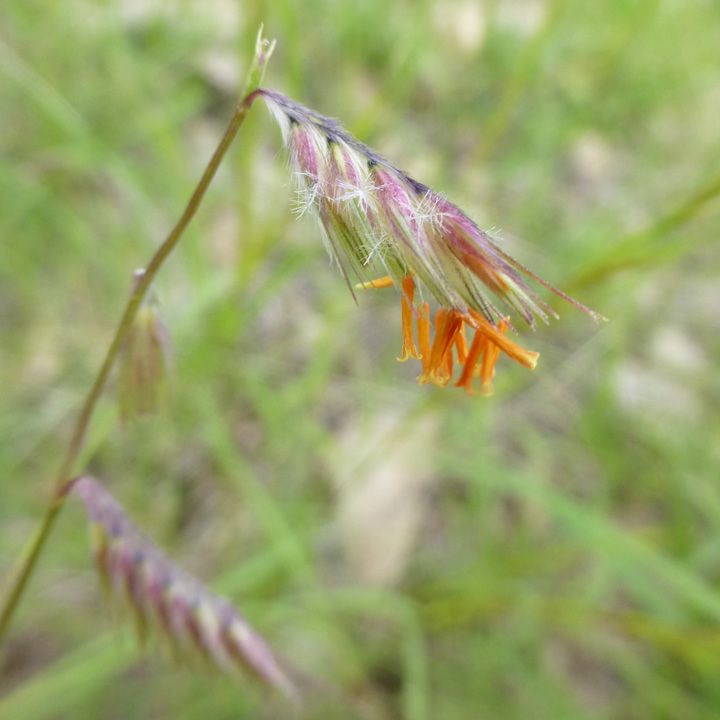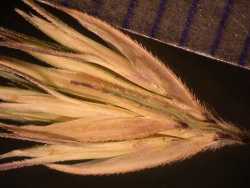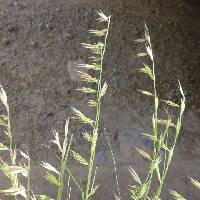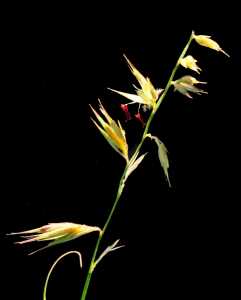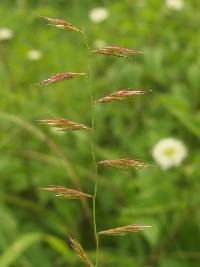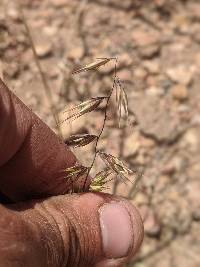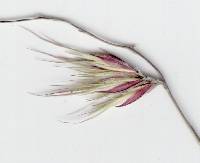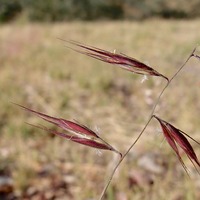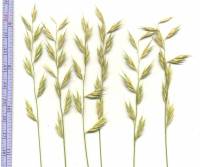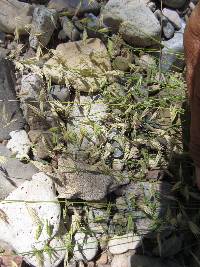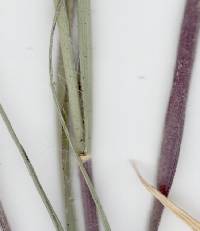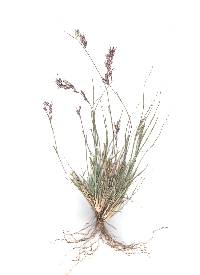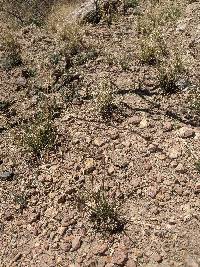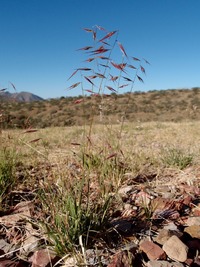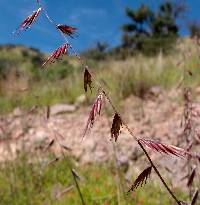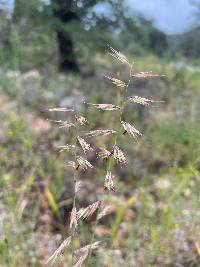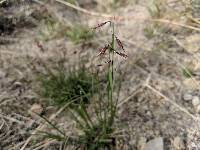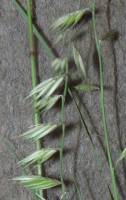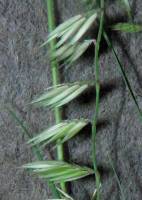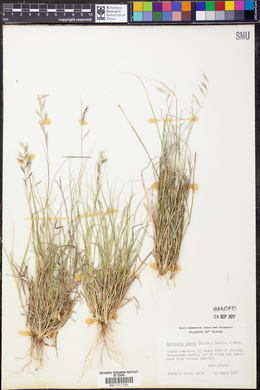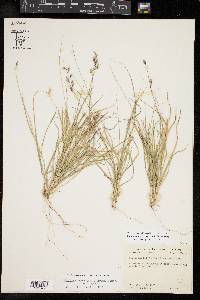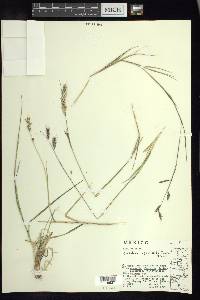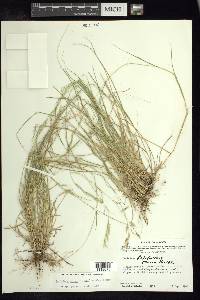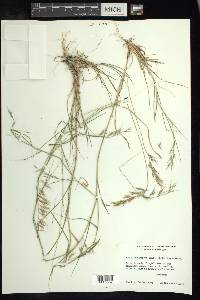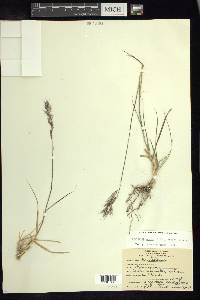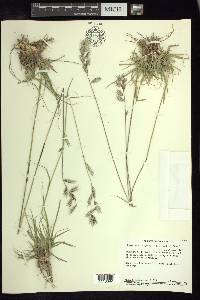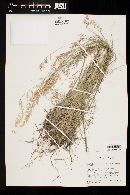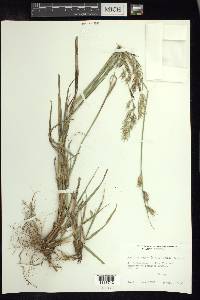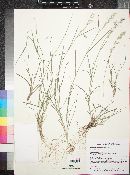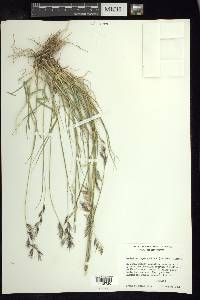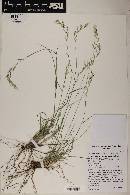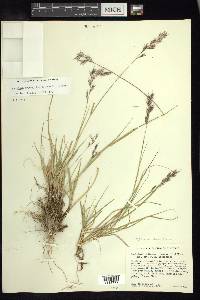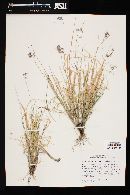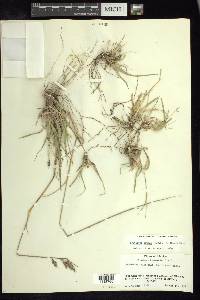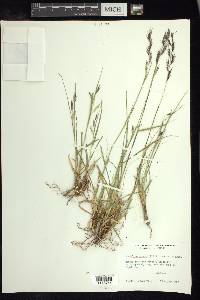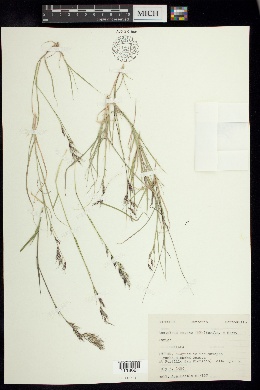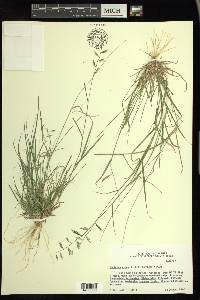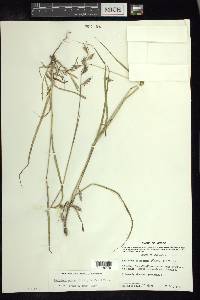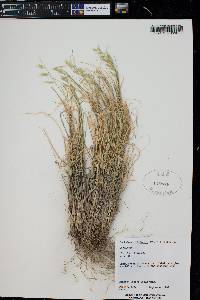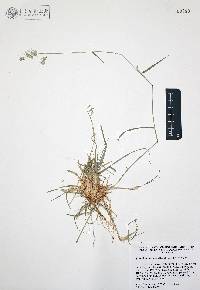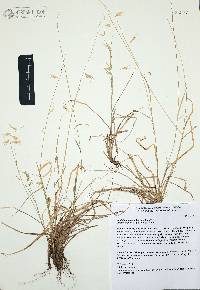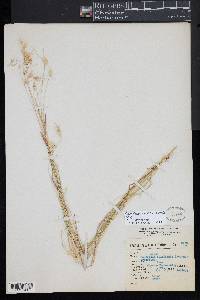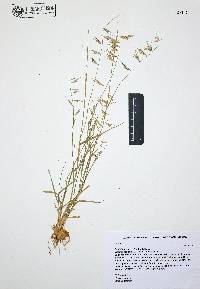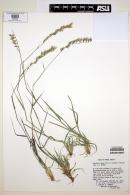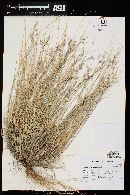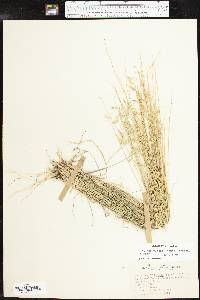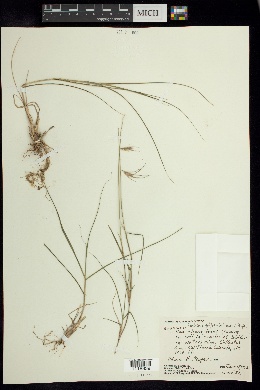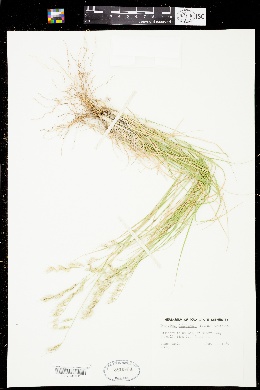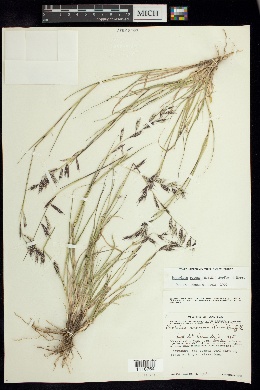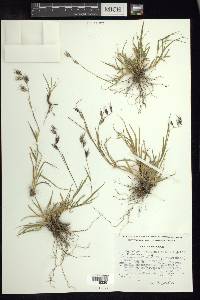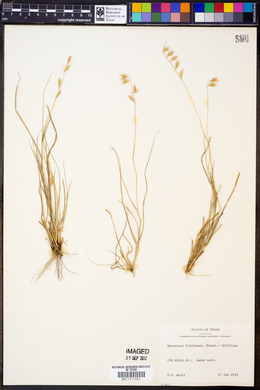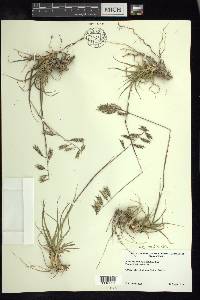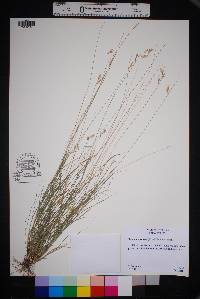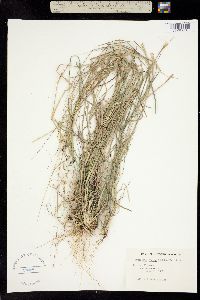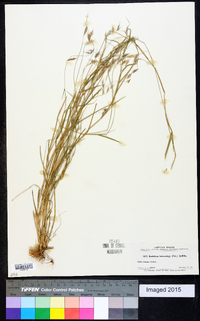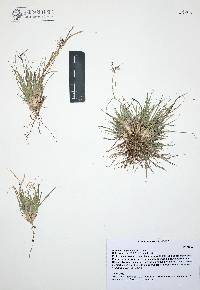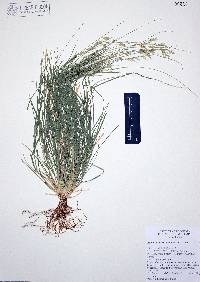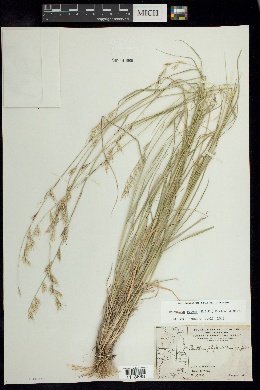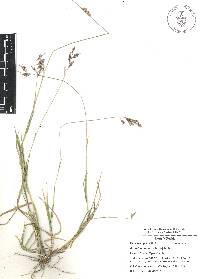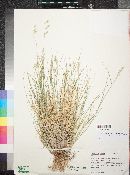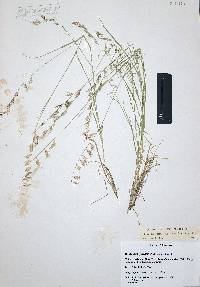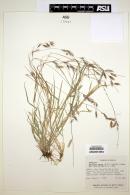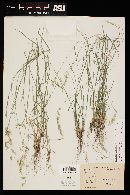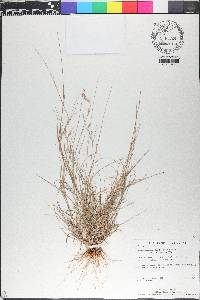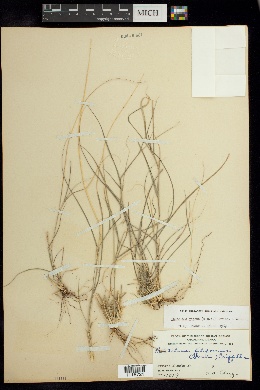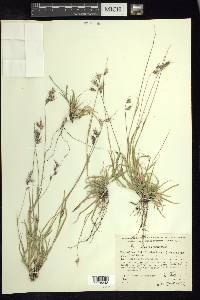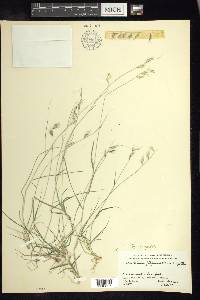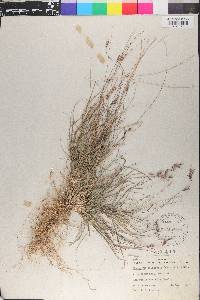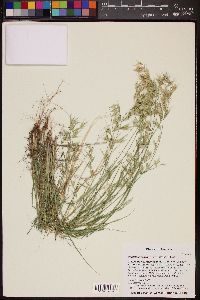Bouteloua repens
|
|
|
|
Family: Poaceae
Slender Grama
[Atheropogon americanus var. depauperatus E. Fourn., moreAtheropogon filiformis E. Fourn., Atheropogon juncifolius (Desv.) Spreng., Atheropogon repens (Kunth) Roem. & Schult., Bouteloua bromoides Lag., Bouteloua bromoides var. bromoides Lag., Bouteloua filiformis (Fourn.) Griffiths, Bouteloua heterostega (Trin.) Griffiths, Bouteloua humboldtiana Griseb., Bouteloua pubescens Pilg., Dinebra juncifolia (Desv.) Steud., Dinebra repens Kunth, Heterosteca juncifolia Desv.] |
Plants perennial; cespitose, usually not dense, hard, or knotty, without rhizomes or stolons. Culms 15-65 cm, erect, geniculate, or decumbent, sometimes rooting at the lower nodes, usually branching from the aerial nodes. Sheaths glabrous or pubescent; ligules 0.2-0.3 mm, membranous, ciliate; blades 5-20 cm long, 1-5 mm wide, bases with papillose-based hairs on the margins, both surfaces glabrous or pubescent. Panicles 4-14 cm, with (3)7-12 branches; branches 10-20 mm, with 2-8 spikelets, extending 4-6 mm beyond the base of the terminal spikelets, apices entire; disarticulation at the base of the branches. Spikelets appressed, all alike, with 1 bisexual and 1 staminate (rarely rudimentary) floret. Glumes glabrous, veins scabrous or strigose; lower glumes 4-7 mm; upper glumes 4-9 mm, mostly glabrous, sometimes scabrous or strigose over the veins, apices acute, unawned or awn-tipped, awns about 1 mm; lowest lemmas 4.5-8 mm, usually glabrous, rarely pubescent basally, 3-awned, awns wide basally, central awns slightly longer than the lateral awns, often flanked by 2 membranous 0.5-1.5 mm lobes; lowest paleas 6-8 mm, bilobed, often shortly 2-awned; anthers 3-5.5 mm, usually orange or yellow, occasionally red or purple; second lemmas 5.5-7 mm, glabrous, 3-awned, central awns 4-10 mm, often flanked by membranous lobes, lateral awns 2-10 mm; second paleas 4-7 mm; anthers smaller than those of the lowest florets; rachillas prolonged beyond the second florets as a short bristle. Caryopses 3-4 mm. 2n = 20, 40, 60. Bouteloua repens grows in open, usually hilly terrain on many soil types, from sandy ocean shores to montane slopes, reaching elevations of 2500 m. Its native range extends from the southwestern United States through the Caribbean islands, Mexico, and Central America to Colombia and Venezuela. Dr. David Bogler, USDA NRCS PLANTS Database Perennials, Terrestrial, not aquatic, Stems nodes swollen or brittle, Stems erect or ascending, Stems geniculate, decumbent, or lax, sometimes rooting at nodes, Stems caespitose, tufted, or clustered, Stems terete, round in cross section, or polygonal, Stems branching above base or distally at nodes, Stem internodes hollow, Stems with inflorescence less than 1 m tall, Stems, culms, or scapes exceeding basal leaves, Leaves mostly basal, below middle of stem, Leaves conspicuously 2-ranked, distichous, Leaves sheathing at base, Leaf sheath mostly open, or loose, Leaf sheath smooth, glabrous, Leaf sheath hairy, hispid or prickly, Leaf sheath hairy at summit, throat, or collar, Leaf sheath and blade differentiated, Leaf blades linear, Leaf blades very narrow or filiform, less than 2 mm wide, Leaf blades 2-10 mm wide, Leaf blades mostly flat, Leaf blades mostly glabrous, Leaf blades more or less hairy, Ligule present, Ligule a fringed, ciliate, or lobed membrane, Inflorescence terminal, Inflorescence with 2 or more spikes, fasci cles, glomerules, heads, or clusters per culm, Inflorescence a panicle with narrowly racemose or spicate branches, Inflorescence with 2-10 branches, Inflorescence branches 1-sided, Inflorescence branches terminating in bristle or point, Flowers bisexual, Spikelets sessile or subsessile, Spikelets laterally compressed, Spikelet less than 3 mm wide, Spikelets with 1 fertile floret, Spikelets solitary at rachis nodes, Spikelets all alike and fertille, Spikelets bisexual, Inflorescence branches deciduous, falling intact, Spikelets secund, in rows on one side of rachis, Rachilla or pedicel glabrous, Glumes present, empty bracts, Glumes 2 clearly present, Glumes equal or subequal, Glumes equal to or longer than adjacent lemma, Glume equal to or longer than spikelet, Glumes keeled or winged, Glumes 1 nerved, Lemma coriaceous, firmer or thicker in texture than the glumes, Lemma 3 nerved, Lemma glabrous, Lemma apex acute or acuminate, Lemma apex dentate, 3-5 fid, Lemma mucronate, ver y shortly beaked or awned, less than 1-2 mm, Lemma distinctly awned, more than 2-3 mm, Lemma with 3 awns, Lemma awn less than 1 cm long, Lemma awns straight or curved to base, Lemma margins thin, lying flat, Lemma straight, Palea present, well developed, Palea membranous, hyaline, Palea shorter than lemma, Palea 2 nerved or 2 keeled, Stamens 3, Styles 2-fid, deeply 2-branched, Stigmas 2, Fruit - caryopsis, Caryopsis ellipsoid, longitudinally grooved, hilum long-linea FNA 2003, Gould 1980 Common Name: slender grama Duration: Perennial Nativity: Native Lifeform: Graminoid General: Tufted perennial grass; stems firm but usually not dense, hard, or knotty; erect, geniculate, or decumbent; usually branching at aerial nodes; without rhizomes or stolons; 30-60 cm tall. Vegetative: Sheaths rounded, not becoming conspicuously flattened; ligules membranous and ciliate, 0.2 to 0.3 mm; blades glaucous, short, flat, 5-20 cm long by 1-5 mm broad, mostly in a basal clump; bases of blades with papillose-based hairs on the margins. Inflorescence: Seven to twelve spicate branches on the upper 3-10 cm of the stem axis, these with 2-8 spikelets on a flattened, ciliate rachis 1-2 cm long; spikelets with a 1 fertile floret below and 1 staminate floret above; glumes subequal, both broadly lanceolate and with a scabrous or scabrous-ciliate midnerve; fertile lemma glabrous or nearly so, the nerves usually extending into short awns; palea as long as the lemma; staminate floret about as long as the fertile floret, with two lateral short-awned lobes and a large central lobe bearing a stout scabrous awn; caryopses 3-4 mm. Ecology: Found on dry rocky slopes, below 5,000 ft (1524 m); flowers August-December. Distribution: AZ, NM, TX; south through Greater Antilles, MEX, C. Amer. to n S. Amer. Notes: This species is a part of a group of Bouteloua very similar in appearance being perennials with short inflorescence branches (sometimes appearing as clusters of spikelets) on both sides of the axis and are deciduous, completely falling off and leaving a small nodule behind. Distinguished from the similar B. radicosa and B. chondrosioides by often having less hair along the rachilla of the spikelets, and most hair restricted to the rachilla and midnerve of the lemmas; 7 - 12 spikate branches; from B. radicosa by lacking a hard, knotty, rhizomotous base; and a generally yellowish or grayish tinge, with often thinner leaves than the others. Ethnobotany: Unknown, but other species in the genus have many uses. Etymology: Bouteloua named for brothers Claudio (1774-1842) and Esteban (1776-1813) Boutelou Agraz, Spanish botanists and horticulturalists; repens means having creeping and rooting stems. Synonyms: Bouteloua filiformis, B. heterostega, Dinebra repens Editor: SBuckley, 2010, FSCoburn 2015, AHazelton 2015 |
|
|
|

